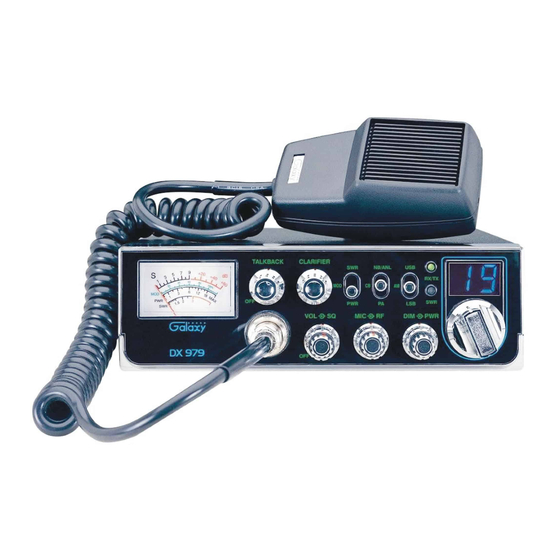Galaxy DX 979 소유자 매뉴얼 - 페이지 6
{카테고리_이름} Galaxy DX 979에 대한 소유자 매뉴얼을 온라인으로 검색하거나 PDF를 다운로드하세요. Galaxy DX 979 13 페이지. Am / ssb two way citizens band mobile transceiver with starlite face plate

PROCEDURE TO RECEIVE AND TRANSMIT
A. MICROPHONE
The push-to-talk switch on the microphone controls the receiver and transmitter.
Press the switch and the transmitter is activated, release switch to receive. When
transmitting, hold the microphone two inches from your mouth and speak clearly in a
normal voice. This transceiver comes complete with a low impedance dynamic
microphone.
B. PROCEDURE TO RECEIVE
1. Be sure that power source, microphone and antenna are connected to the proper
connectors before going to the next step.
2. Turn VOL knob clockwise to apply power to the radio.
3. Set the VOL for a comfortable listening level.
4. Set the MODE switch to the desired mode.
5. Listen to the background noise from the speaker. Turn the SQ knob slowly
clockwise until the noise just disappears. The SQ is now properly adjusted. The
receiver will remain quiet until a signal is actually received. Do not advance the
control too far or some of the weaker signals will not be heard.
6. Set the CHANNEL selector switch to the desired channel.
7. Adjust CLARIFIER control to clarify the SSB signals or to optimize AM signals.
C. PROCEDURE TO TRANSMIT
1. Select the desired channel of operation.
2. Set the MIC GAIN control fully clockwise.
3. If the channel is clear, depress the push-to-talk switch on the microphone and
speak in a normal voice.
- 10 -
RECEIVING SSB SIGNALS
There are three types of signals presently used for communications in the Citizen
Band: AM, USB and LSB. When the MODE switch on your unit is placed in the AM
position, only standard double-side band, full carrier signals will be detected. An SSB
signal may be recognized while in the AM mode by its characteristic "Donald Duck"
sound and the inability of the detector to produce an intelligible output. The USB and
LSB modes will detect upper side band and lower side band respectively, and standard
AM signals.
SSB reception differs from standard AM reception in that an SSB receiver does not
require a carrier or opposite side band to produce an intelligible signal. A single-side
band transmitted signal consists only of the upper or the lower side band and no
carrier is transmitted. The elimination of the carrier from the AM signal helps to
eliminate the biggest cause of whistles and tones heard on channels which make even
moderately strong AM signals unreadable. Also, SSB takes only half the space of an
AM channel, therefore two SSB conversations will fit into each channel, expanding
the 40 AM channels to 80 SSB channels. The reduction in channel space required also
helps in the receiver because only half of the noise and interference can be received
with 100% of the SSB signal.
An SSB signal may be received only when the listening receiver is functioning in
the same mode. In other words, an upper side band signal (USB) may be made
intelligible only if the receiver is functioning in the USB position.
If a lower side band (LSB) signal is heard when the receiver is in the USB mode, no
amount of tuning will make the signal intelligible. The reason for this may be
understood if you consider that when the modulation is applied to the transmitter's
microphone in the USB mode, the transmitter output frequency is increased whereas
in the LSB mode the transmitter's output frequency is decreased.
The result in listening to the receiver is that when the MODE switch is in the proper
position (either USB or LSB), a true reproduction of a single tone of modulation will
result, and if the tone is increased in frequency (such as a low-pitched whistle or a
high-pitched whistle) you will hear the increase in the output tone of the receiver. If
the incorrect mode is selected, an increase in tone of a whistle applied to the
transmitter will cause a decrease in the resultant tone from the receiver.
- 11 -
